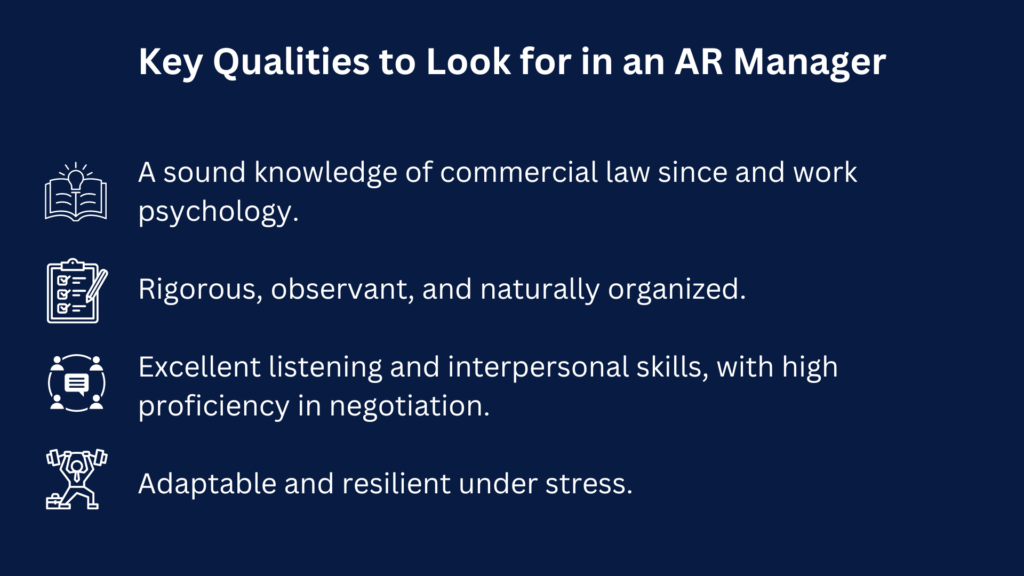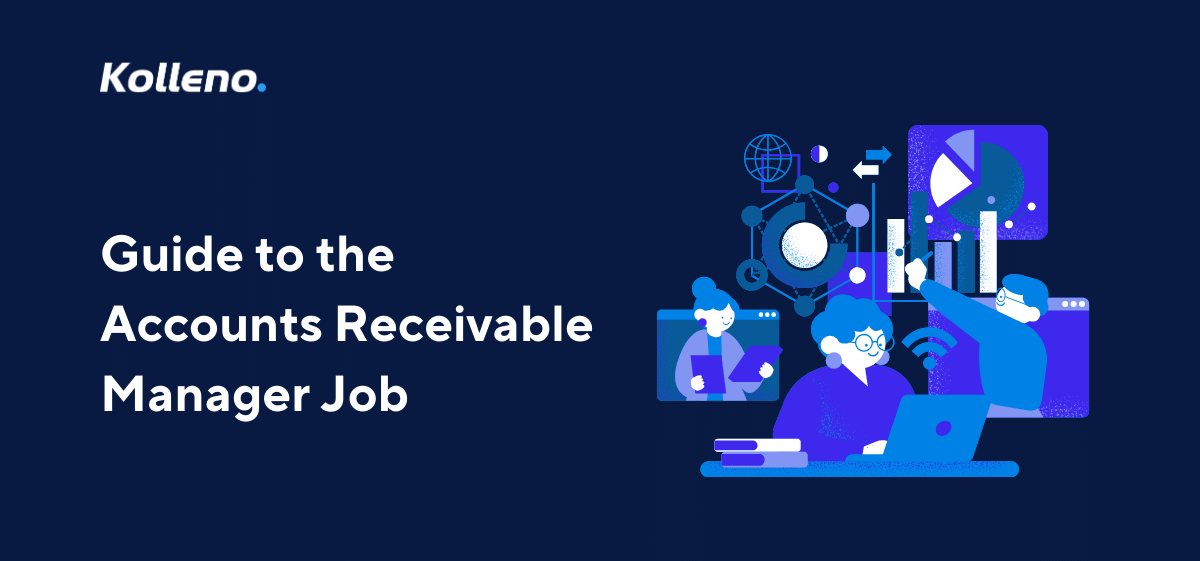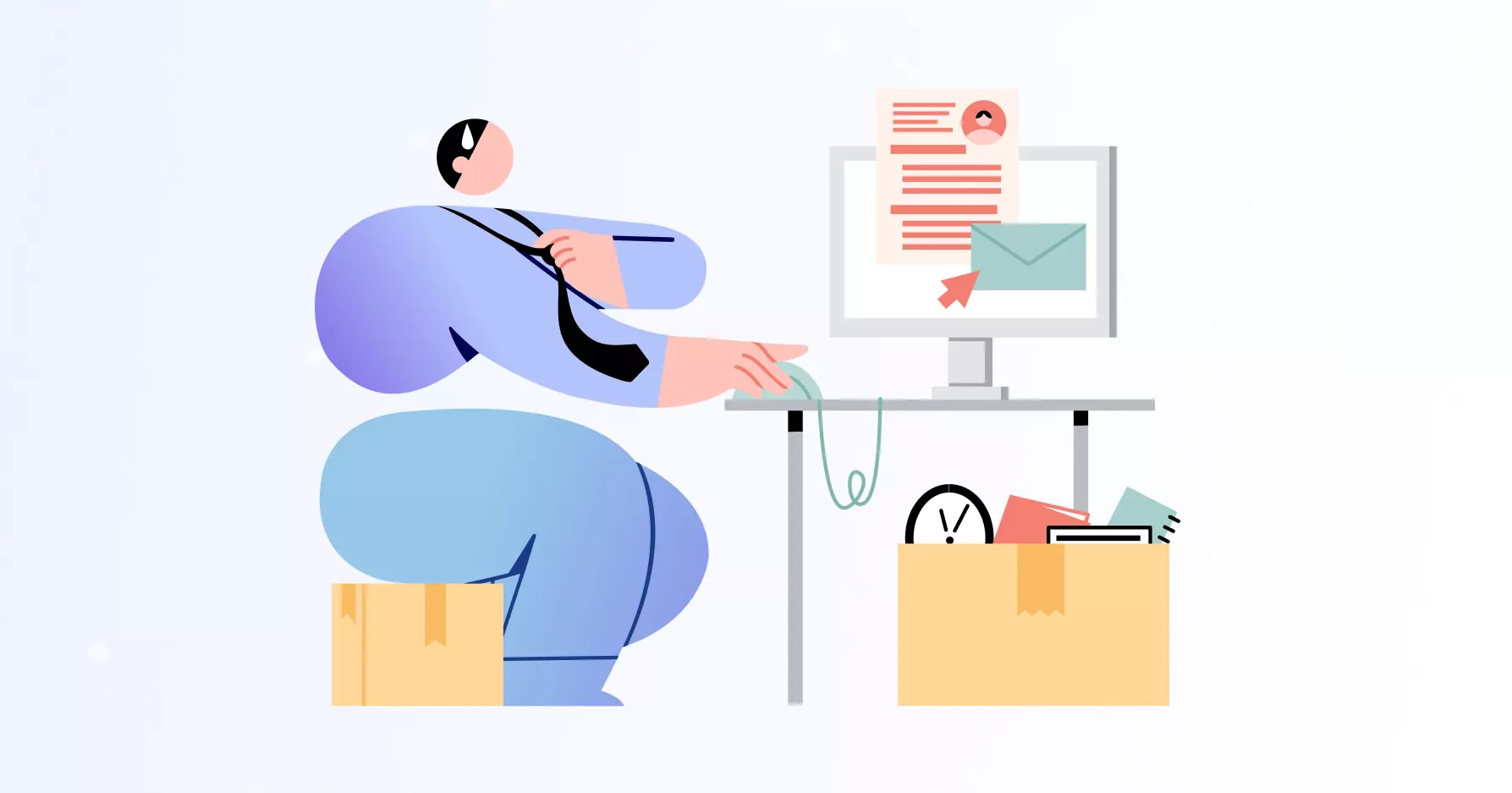Running a business requires maintaining a healthy cash flow. If your accounts receivable are piling up, it can significantly strain your finances. To address this, a skilled team of Accounts Receivable Managers is essential. These professionals play a crucial role in safeguarding your cash flow and ensuring financial stability. Recruiting ambitious, goal-driven Accounts Receivable Managers could be one of the best investments for your company’s future.
The Accounts Receivable Manager: a company’s key asset
So, what exactly does an Accounts Receivable Manager do? What are their key duties and KPIs?, and how does this impact the wider business?
Ensuring timely payments
Accounts receivable are payments due to your company for services or products already supplied. Good accounts receivable management ensures these payments are made on time, consistently and reliably. Suppose your receivable team doesn’t manage its collections effectively, and there’s a widespread and persistent problem of overdue payments. In that case, you risk not having enough cash flow to pay essential transactions such as salaries, purchases, and dividends.
Accounts receivable management encompasses several different processes. It includes credit granting, customer relations, invoicing, monitoring and analyzing payment trends, and collecting and reconciling payments received. Effective management directly impacts the company’s liquidity, working capital, and overall financial health.
To process payments, the best tools include Stripe, Adyen, and GoCardless to provide a range of payment options to customers globally and ensure secure, efficient, and seamless transactions across various platforms, with support for multiple currencies, advanced fraud detection, and integration capabilities with e-commerce systems.
A positive impact on the entire organisation
Because of its scope, good accounts receivable management services can impact the business in many ways.
- The most obvious of these is the reduction of bad debts. No company wants to be burdened with too many unpaid invoices or overdue payments. Having sound, reliable payments from customers ensures that you will avoid non-payments, and instead keep sufficient cash flow to finance the ongoing needs of your business. According to research by the FSB, every year, 50,000 businesses are pushed into bankruptcy in the UK as a direct result of late invoice payments. An efficient and reliable payment collection process is therefore vital.
- An efficient accounts receivable management program will help your staff focus on the critical, high-value work that supports your bottom line. Often, Accounts Receivable Managers create templates for internal use to ensure that the process is as systematised as possible
- A well-managed accounts receivable management program fosters good customer relations and your company’s reputation. Good accounts receivable management maintains healthy customer relationships and strengthens your company’s reputation. Poor customer relations could harm your company’s customer loyalty and its ability to close good business in the future.
- Finally, the strength of your accounts receivable management program can impact your investor relations and your ability to grow. Cash flow can impact your balance sheet and bottom line. Investors and lenders assess your company’s financial health through effective AR management and payment history.
The account manager as a tightrope walker
So, how do you become an outstanding accounts receivable manager? By maintaining the subtle balance between chasing and nurturing your customers.
Accounts Receivable Managers are in a very tricky position when chasing overdue payments from customers. They must contact them to settle their debts as quickly as possible, while still maintaining a positive relationship with them.
“At Kolleno, we recognize the vital role that Accounts Receivable Managers play in maintaining a company’s financial health. Effective management of accounts receivable ensures timely payments, reduces bad debts, and significantly improves cash flow, which is essential for sustaining day-to-day operations and fueling growth. Our goal is to empower these professionals with the best tools and strategies to foster healthy customer relationships while safeguarding the financial stability of the business. Investing in skilled, goal-driven Accounts Receivable Managers is a strategic move that will pay dividends in the long run.”
— Djibrane Larrabure, CFO of Kolleno
Accounts Receivable Managers sometimes work with the Credit Manager and the Head of Litigation to ease tensions related to customer accounts, settling the company’s commercial disputes and litigation as best they can. Sometimes, this may mean negotiating with customers in difficult financial situations and being flexible with payment plans and payment methods.
Put simply, Accounts Receivable Managers must act in a way that does not harm the trust and the relationship between a customer and the business.
The importance of omnichannel communication
Embracing omnichannel communication is essential as it allows the manager to engage with clients seamlessly across various platforms, ensuring accessibility and convenience for all parties involved. What’s more, personalised communication is paramount in cultivating trust and loyalty.
By tailoring interactions to individual client preferences and needs, Accounts Receivables Managers show they’re committed to understanding and addressing clients’ specific concerns. In turn, this enhances overall client satisfaction and facilitates smoother transactions.
Research by McKinsey proved most late payers prefer digital channels communication, except among older cohorts who enjoy traditional contact through letters and telephone. The takeaway? Don’t adopt a one-size-fits-all approach. Every customer is different, with their own individual preferences and needs.
Personalised communication
Addressing late-paying customers in a friendly and personalised manner is crucial for an Accounts Receivable manager. It helps to ensure a positive relationship with the customer, preserving goodwill and potentially preventing any further delays in payment. The manager’s friendly approach shows empathy, motivating the customer to prioritise paying their balance.
Moreover, personalised communication shows that the manager values the customer as an individual rather than just another account. This can lead to a sense of importance and respect for the customer, fostering loyalty and a willingness to cooperate in resolving the customer payment issue promptly.
Friendly and personalised communication can also uncover underlying reasons for the late payment, such as financial difficulties or internal processing challenges. By opening up a dialogue in a non-confrontational manner, the manager may be able to identify solutions or alternative payment arrangements that work for both parties, ultimately facilitating quicker resolution of the outstanding balance
How to avoid confusion and ensure swift payment
Confusion is an Accounts Receivable Manager’s kryptonite. Disaggregated, unreliable data or discrepancies in financial reports are their worst enemy.
Thankfully, by following the steps outlined below, you can banish all confusion from your accounts receivables process.
Establish a set of clear policies
Good Accounts Receivable Managers establish a set of policies that clearly define credit terms for your customers. These might include provisions such as the level of credit that can be granted, payment terms, interest, and a metric for what constitutes a default and how the policies will be enforced.
Clear credit policies help mitigate credit risk by defining the criteria for extending credit to customers. It also ensures consistency in credit decisions across different customers and transactions. This consistency promotes fairness and transparency, reducing the risk of favouritism or discrimination in credit terms.
More importantly, transparent credit policies contribute to positive customer relations by setting clear expectations regarding payment terms and credit terms. Customers appreciate clarity and predictability in their financial dealings with suppliers, leading to improved satisfaction and loyalty.
Create a comprehensive process
Accounts Receivable Managers create a comprehensive process for determining credit eligibility, designing guidelines to offer flexibility and options for expanding the customer base while ensuring risk exposure is minimised. This involves having a solid grasp of the big picture, combined with some smart forecasting.
They know they shouldn’t extend credit to customers who aren’t creditworthy, and the amount of credit they extend should reflect a reasonable consideration of risk, product value, and the customer’s ability to pay. They base their decision-making on the review of financial statements and credit scores, customer’s net worth, and payment history.
Follow strict invoicing protocols
Invoicing is a key factor in outstanding accounts receivable management, in addition to credit approvals and data management. Without accurate invoices, there is no efficient AR management. AR managers need organised records of the work, products, and/or services the company will be billing for. These invoices should include all the conditions agreed upon with the customer to avoid disputes. They should also send invoices as early as possible to avoid delays.
Keeping your data clean
The quality of the data your Accounts Receivable manager collects on your customers, and how it’s stored, is a crucial element that can impact their performances. Master data is a commonly used term for the basic static information kept on your customers. It contains information on customer profiles, such as company name, address, and bank account, but not transaction data.
Master Data Management (MDM) is the process of maintaining this information in a centralised location that’s standardised, accessible, and secure. MDM is vital as customer data can become problematic in many ways. When different departments in your company enter data on the same customer using different platforms or formats, or without standardisation, you’ll have duplicate records that are difficult to interpret and use. This can strain your receivables when you need the data to process overdue payments.
Therefore, implementing an MDM system is a good practice for Accounts Receivable management. It enables your company to establish an information master record—a single, well-defined repository of all your organisation’s data across all departments and platforms.
With clear policies in place, clearly defined terms and an understanding of the type of data they are collecting, AR managers can keep their data clean. They can even establish protocols for frequently checking the quality of their data to eliminate erroneous or contradictory information.
How can you spot an outstanding accounts receivable manager?
Hiring a great Accounts Receivable manager will have a tremendous impact on your cash flow. So, how can you identify the right person, who you can trust to look after your company’s financial health?
Look for someone with the following qualities:
- A sound knowledge of commercial law since they manage business and commercial disputes and of work psychology.
- They need to be rigorous, observant, and naturally organised and tenacious, especially when reminding customers until payment has been received. They have a perfect command of debt collection software and enforcement procedures.
- Excellent listening and interpersonal skills since they constantly contact the company’s customers. They must also be highly diplomatic to obtain payment from indebted customers despite their financial situation. This means they’re very good at negotiating while remaining sympathetic to customers.
- They can also adapt to all kinds of situations and know how to manage stress.

How to empower accounts receivable managers with automated tools
Given its importance, it’s crucial to invest in measures that maximise your business’s accounts receivable efficiency. For example, such as automation which streamlines key accounts receivables processes and boosts efficiency. In fact, a PYMNTS’ 2023 study directly links AR automation with reduced days sales outstanding (DSO). Our CEO and Co-Founder, Dimitri Raziev, wrote an article in Forbes detailing how AI is used in accounts receivable to automate manual tasks and save hours of time for the office of the CFO.
Here’s how to find the right automated solution for your business.
Optimising invoice generation and distribution: Automation software can generate invoices automatically based on predefined criteria, such as sales orders or service delivery. It can then distribute these invoices via email or electronic invoicing platforms, reducing manual effort and ensuring timely delivery. According to a PYMNTS 2023 study, 63% of interviewed CFOs credited automation for fewer invoicing errors.
Payment reminders: Automated reminders can be scheduled to alert customers about upcoming or overdue payments, reducing the need for manual follow-up and improving collections.
Payment reconciliation: Automation tools can match incoming payments with outstanding invoices, reconciling accounts receivable records accurately and efficiently.
Credit management: Automated credit assessment processes can help an accounts receivable department evaluate customers’ creditworthiness, set credit limits, and monitor credit terms to minimise the risk of late payments or bad debts.
Data analysis and reporting: Automation software can aggregate data from various sources, providing Accounts Receivable Managers with insights into payment trends, customer behaviour, and collection performance. This data-driven approach enables informed decision-making and proactive strategies to optimise cash flow and reduce DSO (Days Sales Outstanding).
Integration with ERP systems: Automation solutions can seamlessly integrate with enterprise resource planning (ERP) systems, facilitating the exchange of information between accounts receivable, sales, and finance departments, thereby enhancing overall operational efficiency and accuracy.
By leveraging automation technologies, Accounts Receivable Managers can streamline routine tasks, reduce manual errors, improve communication with customers, and focus more on strategic initiatives such as optimising cash flow, reducing outstanding balances, and enhancing customer relationships.
You can learn more about the benefits of automating your financial operations and practical applications of automation tools for accounts receivable managers in our partnered webinar with QuickBooks.
Final thoughts
Accounts Receivable Managers are the unsung heroes of cash flow management within businesses, playing a pivotal role in ensuring financial stability and growth. Effective accounts receivable management is far more than just chasing overdue payments; it’s a multifaceted process that encompasses credit granting, invoicing, customer relations, and data management.
The impact of sound accounts receivable management reverberates across various aspects of a business, from reducing bad debts and improving cash flow to fostering positive customer relationships and bolstering investor confidence. The intricate balancing act required of Accounts Receivable Managers, navigating between assertive debt collection and nurturing customer relations, underscores their importance as strategic assets within organisations.
Moreover, the advent of automation technology presents an unprecedented opportunity for Accounts Receivable Managers to elevate their accounting software along with their efficiency and effectiveness. By harnessing the power of automation tools, such as accounts receivable software, for invoice generation, collecting payments, payment reminders, credit management, data analysis, and integration with ERP systems, Accounts Receivable Managers can streamline operations, minimise errors, and focus on value-added activities that drive business success.
Learn from Jordan Hickson, the Accounts Receivable Manager at DNA Payments, what it is like to use an automation tool for accounts receivable management and the results that can be achieved with it.











